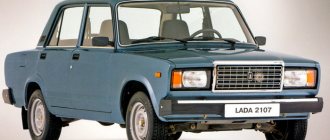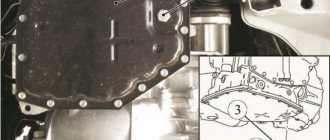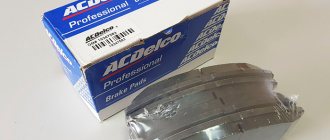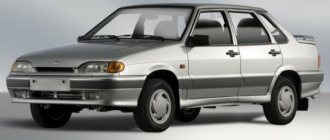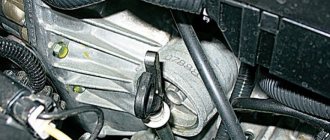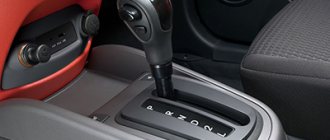When choosing which oil to pour into an automatic transmission, you need to consider a number of factors. Firstly, it differs in many ways from manual transmission oil, since there are features unique to ATF (Automatic Transmission Fluids). For example, participation in the transmission of power from the internal combustion engine to the wheels in the torque converter of an automatic transmission and control of its modes.
In addition, if the car has friction blocks, the oil must constantly provide high-quality friction when the friction clutches come into contact. That is, it should simultaneously reduce the coefficient of friction in loaded units and increase friction in the friction discs.
It turns out that ATP is subject to mutually exclusive requirements, and requires a very sensitive approach to the choice of additives.
Decoding the markings of transmission oils for automatic transmissions
One of the main indicators that you need to look at when choosing oil for an automatic transmission is its viscosity. It directly affects the ability of the composition to continuously lubricate the entire surface of the parts. With the correct oil viscosity, the transmission can operate smoothly at low temperatures. Its efficiency increases and hydraulic losses decrease.
The viscosity of lubricant for automatic transmissions is determined according to the SAE J 300 DEC 95 classification. It is measured in numbers and can take values from 4.1 to 41. Depending on the viscosity, the oil is divided into classes. When choosing, they are guided by the operating conditions of the vehicle and climatic conditions.
Winter classes are designated from 70W to 85W in increments of 5 units. The "W" stands for "winter." The lower the number, the more resistant the oil is to temperature changes.
For example, for 70W the lowest temperature is -50 degrees, and for 75W it is already -40 degrees. Summer oils are simply indicated by numbers. They start at 80 and end at 250. There are also multi-grade oils, such as SAE 80W-90.
API characteristics indicate the quality of the oil’s performance of its tasks:
- API GL-1…5. Indicates the quality of the oil. With number 1, the lubricant is capable of performing the simplest tasks; class 5 is characterized by work under higher loads.
- MT-1 API. This is a new category, identical to API GL-5, but with greater heat resistance.
These properties of oils determine their ability to work in various conditions.
Characteristics of transmission oil for automatic transmission
Like engine fluids, transmission fluids can be synthetic and semi-synthetic, original, recommended by the automatic transmission manufacturer, as well as universal. Synthetic ones initially have excellent quality, retain their properties at both high and low temperatures and have a longer service life.
Their use is permitted in almost all automatic transmissions (older cars may be an exception). Semi-synthetics are more affordable, but in a number of indicators they are inferior to synthetics.
Composition of ATF oils for automatic transmissions
Since the properties of ATF are very diverse, manufacturers often hide their composition. The liquid is very complex. Only a general idea can be obtained about the molecular composition of lubricants for automatic transmissions.
In terms of its chemical composition, car transmission oil consists of a base and a package of additives.
The basis, as already mentioned, can be of several types:
- synthetic;
- mineral;
- semi-synthetic.
Petroleum and paraffin oils are used as a mineral base. Semi-synthetics are represented by hydrated mineral-based compounds. Polyalphaolefin oils are truly synthetic. They are produced using complex and expensive technology.
In addition to the base, up to 15% of the composition is occupied by additives:
- preventing the formation of foam;
- anti-wear;
- corrosion inhibitors;
- friction modifiers;
- antioxidant;
- dispersants that hold wear products in suspension.
This fluid composition ensures proper operation of the automatic transmission for a long time.
Original oils for automatic transmissions
Original oil is the one that is strongly recommended or produced by the car manufacturer itself. Such oils are used by official services; ATF is often sold under the brand name of the car manufacturer. The risks of possible machine malfunctions due to the use of unsuitable oil are eliminated, but its price is quite high.
Each manufacturer determines its own labeling and composition tolerances for the machine. These requirements are almost identical to each other. Most famous endorsements:
- GM (DEXTRON II, III, IV),
- Mitsubishi-Hyundai-Kia (SP-II, III, IV, Red-1),
- Toyota (T, T-III, IV, WS).
In addition, the automatic transmission manufacturer itself can provide information about which analogues can be used in a particular gearbox. For example, for different gearboxes Aisin, Jatco, and so on, you can separately indicate tolerances and recommendations for oil, as well as suitable ATF options, that is, there is a choice. At the same time, the price of analogues is cheaper than the original.
Car manufacturers themselves do not produce transmission oils. This is done by companies that produce universal formulations. Often the branded canister contains the same non-original liquid, only at an inflated price.
Universal gear oils
Universal ATFs have a maximum additive package, which allows them to work in various types of automatic transmissions. They are beneficial, but the risks of automatic transmission failures cannot be completely eliminated.
These ATFs meet the approvals of several manufacturers at the same time and are suitable for different models.
It is much easier to select a universal analogue of the original ATF oil for European cars. This is due to European antitrust laws. It is more difficult to find fluids for a Japanese car.
Advantages and disadvantages
Like any metal, material, part or anything else, ATF 2 lubricating fluid from ZIK has its pros and cons.
The lubricant has advantages over its competitors:
- stable during thermal-oxidative processes;
- Compatible well with any seal material;
- at any temperature, especially sub-zero, the gear shifts smoothly, clearly and comfortably;
- the transmission operates silently;
- there are properties - high anti-corrosion;
- when used at low temperatures, fluidity is high;
- The service life of all systems is extended.
If the fluid is used in accordance with all regulations and instructions, the transmission oil in question cannot have any deficiencies.
How much oil to pour into automatic transmission
ATF oils intended for automatic transmissions are included in a separate category of lubricants. They are most often produced in red, but some manufacturers use other colors.
The required amount of oil for an automatic transmission is determined by which replacement option is proposed:
- full or partial,
- hardware replacement using the displacement method or the oil will be changed “by spilling”.
Based on this, you can more accurately understand how much ATF oil may be needed in an automatic transmission.
In most cases, to completely change the oil in an automatic transmission using the “spill” method, at least 10-12 liters of transmission oil are required.
When replacing using the displacement method - more.
For a partial replacement, when the ATF oil is not changed but updated, 4-5 liters are enough.
Important. With such a replacement, it is undesirable to mix different oils in the automatic transmission, especially with different bases.
Timing for changing transmission oil in automatic transmissions
Oil changes in automatic transmissions are not performed as often as in engines. The manufacturer's recommendations indicate when to change the oil under normal or severe vehicle operating conditions. In the latter case, replacement is carried out almost twice as often.
Severe conditions include:
- dynamic driving – quick start and sharp braking;
- operating the car in urban conditions, which reduces the quality of the oil in the box;
- work in difficult weather conditions - in the cold (below -20) or in the heat (above +35);
- long-term operation of the vehicle at maximum loads;
- regular off-road driving: rocks, snow, gravel.
In old cars, the oil is changed every 30-40, in new cars - 50-60 thousand km.
In a car with an automatic transmission, compared to a manual transmission, the pressure on the plungers is less, so the oil must be thinner.
How to avoid rapid blackening of petroleum products
There is no 100% way to avoid blackening of the grease. However, there are certain rules, compliance with which makes it possible to maximize the service life of the consumable.
- Choose the right oil fluid. If the oil is of low quality, it must be changed.
- The lubricant must have good performance. When choosing a consumable, you need to take into account not only the brand of petroleum product, but also its characteristics. Transmissions from different manufacturers function differently, so the optimal consumables must be selected for each gearbox.
- The vehicle specification must match the transmission specification. It happens that lubricant cannot be poured into any model of car. In this case, you need to read the gearbox specification and choose a different oil.
- Monitor the condition of the automatic gearbox. If the transmission is severely worn, it must be repaired. It may be enough to replace certain parts.
- Wash the unit. Follow the specified flushing intervals. It's quite easy to do. If this procedure is difficult for you, contact a specialized service center.
What kind of oil is needed to fill an automatic transmission?
Let's dive into specifics. What kind of oil does the manufacturer recommend to put in the box and what are its requirements? We will look at the most popular car brands.
Transmission oil for automatic transmissions of American-made cars
Ford is the most popular among American cars. Focus, Fiesta, S-Max models have a unique and unpretentious 4-speed 4F27E. Low viscosity oils, such as Dexron VI or Mercon LV, are poured into automatic transmissions. Low-viscosity fluid heats up faster in winter, which reduces the risk of damage to the automatic transmission clutch.
Since 2008, Ford has partnered with Getrag to develop PowerShift preselective automatic transmissions. The box is installed in Focus, S-Max, Mondeo, Fiesta, Kuga. Automatic transmissions are sensitive to the quality and type of gear oil, so it is better to change it after reaching 50,000 km. Fits well in the box Ford BO-DC art. 1 490 763 1 940.
Chevrolet Aveo, Captiva, Cruze, Epica with 6T40 / 6T45 automatic transmission run on Dexron VI synthetic oil. Shift units are set to operate at the limit, and excessive torque load will quickly lead to transmission failure. Hydraulics are no less demanding on the quality of oil, so it must be changed when it becomes dirty.
The Chrysler 300, Dodge Dakota and Jeep Cherokee 42RLE, 5-45RFE automatics are reliable, without too delicate electronics and will last a long time if not loaded to the limit. They operate on Mopar ATF 4+, Dexron III – VI class fluids.
What kind of oil to pour into the automatic transmission of European-made cars
Among European cars, Volkswagen, Skoda and Renault sell well in Russia. They are mainly equipped with Japanese hydraulic automatic transmissions or German robotic gearboxes.
Thus, the Czech Skoda installs six-speed TF-60SN automatic transmissions on Fabia, Octavia, and Superb. A modification of this box is also available in VW Polo. The automatic transmission is proven, reliable, but sensitive to ATP levels. Original oils for automatic transmissions are T-IV or WS, depending on the design.
The Skoda Kodiaq is only available with DSG-6 or DSG-7. The same robots are found in the Audi A3, Q3, and VW Tiguan. They accelerate quickly, save fuel, but are susceptible to overheating and off-road driving. It is recommended to change the VAG G 052 182 A2 oil every 40-60 thousand km.
All-wheel drive Renault Duster and Kaptur are equipped with a DP8 automatic transmission. The torque converter lock-up developed by ZF is already engaged at first speed. Before a major overhaul, the automatic transmission can travel 200,000 km with careful operation. You can pour Renaultmatic D3 SYN art. 156908 or Dextron 3.
Mercedes Benz models of the CL, CLC, E, G Wagon, SL, Viano classes are very popular in the secondary market. These vehicles are equipped with the 722.6 automatic transmission, which is also found in American Dodges and Jeeps.
The box is repairable and can last forever if you change the oil, filter and consumables on time. 722.6 is filled with synthetic oil A with approval MB 236.14. Although in theory the oil is irreplaceable, in practice after 100,000 km it becomes dirty and the performance of the gearbox deteriorates.
Oil for automatic transmissions of Russian-made cars
Among domestic models, Lada Granta and Lada Vesta are in demand. At the same time, the demand for manual transmissions is higher than for cars with automatic transmissions. Although the Granta has a 4-speed Jatco JF414E - a reliable hydraulic automatic transmission.
The box is undemanding in terms of gear oil, and instead of the original Nissan Matic-S art. 999MP-MTS00P, the automatic transmission perfectly accepts any ATF Dextron 6.
The first Vesta was equipped with an AMT robot specially designed for Lada. At the plant, Tatneft TM-4-12 SAE 75W-85 API type GL-4 was poured “for the entire service life” or 5 years. But experts recommend changing the oil every 75,000 km.
Since 2022, Lada Vesta has been sold with the Jatco JF015E variator. This machine is designed for economical trips around the city. Aggressive driving overloads the belt and bearings of the variator, which leads to their rapid wear.
The automatic transmission is sensitive to cleanliness and lubricant level, so it needs to be changed after 40,000 km. This machine is filled with synthetics for a CVT gearbox of the Nissan NS-3 type, art. KLE53-00004.
What to put in the automatic transmission box of Korean cars
Korean-made cars are mainly equipped with Hyundai-Mitsubishi automatic transmissions running on SP specification oil. Korean automatic transmissions are not demanding on oil, but it is recommended to change it as soon as it loses its transparency. Best-selling automatic Kia and Hyundai models:
Kia Sportage, Sorento, Hyundai Sonata, Santa Fe – modifications F4A51, SP-III semi-synthetic oil, art. 04500-00400, or equivalent Dextron 3.
Kia Ceed, Cerato, Rio, Soul, Hyundai Accent, i20, i30, Solaris – A4СF modifications, semi-synthetic SP-III, art. 04500-00400, or equivalent Dextron 3.
Kia Optima, Rio, Sorento, Sportage, Soul, Hyundai Creta, i30, ix35, Santa Fe, Sonata, Solaris, Tucson – A6LF modifications, synthetic SP-IV, art. 04500-00115.
Kia Mohave, Opirus, Hyundai Equus, Genesis – A8LR1, synthetic SP-IV RR, art. 04500-00117
Transmission oils for automatic transmissions of Japanese cars
Toyota, Nissan and Mitsubishi are popular among Japanese cars. Each manufacturer equips cars with its own automatic transmission. The oil for these automatic transmissions meets each company's standards.
The most popular are Toyota Rav 4 and Camry. These machines are equipped with Aisin U660 boxes. The automatic transmission shifts in less than half a second, saves fuel and operates smoothly, but suffers from rapid wear on the clutch and torque converter. The car runs on Toyota WS synthetics, which can retain its properties at + 130℃.
Nissan prefers to install CVTs in its cars. Qashqai, Tiana, Tiida, X-trail are equipped with the best-selling variator – JF011E. It does not bug, is repairable and, if used correctly, lasts almost forever. But it is picky about the purity of the oil. To increase the resource of the box up to 200,000 km Nissan NS-2 art. KLE5200004EU is recommended to be replaced when dirty.
Mitsubishi's hit is the Outlander, equipped with a JF011E CVT or a JF613E six-speed automatic transmission. This box is also found in Nissan and Renault models. The hydraulic system does not like extreme conditions and overheating.
With quiet driving, major repairs can be postponed up to 200,000 km. Oil change Nissan Matic-S art. 999MP-MTS00P – partial, upon reaching 60-80,000 km.
Universal liquid
Such ATFs meet the tolerances of several manufacturers at once. They are used by owners of different models. Among the advantages of non-original liquids are:
- cheapness;
- wide choice of manufacturers;
- The quality most often corresponds to the original oils.
Disadvantages of universal transmission fluids:
- it is necessary to know the tolerances;
- there is a possible risk of transmission breakdown if the wrong fluid is selected;
- removing the car from warranty.
Selecting a universal ATF analogue is much easier for European-made cars. This is due to European antitrust laws. Buying fluid for a Japanese car is more difficult.
There are many resources for selecting oil by VIN - vehicle identification number.
Interchangeability of transmission oils
The automatic transmission of 90s cars was created in the late 80s, and no structural changes occurred until 2003. Therefore, new ATF cannot be poured into automatic transmissions of cars from the 90s.
There are certain nuances of replacing modern oils:
Dexron II can be replaced by Dexron III (but not vice versa) if the equipment allows for an increase in modifiers that can reduce friction. This group includes GM boxes.
In cases where the equipment cannot reduce the coefficient of friction by increasing the effectiveness of the additives, Dexron III cannot replace Dexron II.
Regardless of hardware, Dexron IIE replaces Dexron IID, but not vice versa. Replacement is often due to the fact that Dexron IID does not tolerate frost well - it is suitable for use at temperatures not lower than -15. It is worth considering that Dexron IIE is needed only in the northern regions and costs 2-3 times more.
Is it possible to mix ATF oils from different manufacturers?
When stirring, sediment may appear - white flakes that can clog the transmission. First of all, CVTs and automatic transmissions suffer from this. If the filters become clogged, the system will quickly fail. In some cases, no sludge will form, but the performance of the transmission is at stake.
Important! Mixing synthetics and mineral water will not result in semi-synthetics.
But a lot of foam is formed, which after 500 km thickens and forms precipitation. The oil seal may be squeezed out. If whitish flakes are detected, the system is completely flushed.
How to find out what kind of oil needs to be poured into an automatic transmission
You can determine the type of transmission oil for an automatic transmission in the following ways:
- Inspect the automatic transmission dipstick - usually the recommended ATF for this car is indicated there;
- Look at the plate under the hood - the ATF type may also be indicated there;
- Study manufacturers' catalogs or contact a service station.
The color of the ATF does not affect anything. It depends only on the dye and is necessary for rapid identification.
And you need to remember that some car manufacturers (for example, Honda and Mitsubishi) strongly recommend using not just any oil in automatic transmissions, but only specialized ones, otherwise the manufacturer cannot guarantee normal operation of the automatic transmission.
Yellow is DIID synthetic, red is mineral water
Yellow is DIID synthetics, red is mineral water. The box will need to be washed. DO NOT MIX WITH RED! Or change to synthetics too.
Red can also be type 4 synthetics; Castrol type 4 is red-orange.
If the stuff in the box bothers you, change it completely; don’t bother; you’re unlikely to find type 2, although maybe. lei type 4 - compatible with all.
And who told you that T4 is synthetic? :) Did you read the label on the can? :) I won’t say anything about Kstrol. But there is no need to advise nonsense from the T4 series that is compatible with everyone! You need to pour what is written on the dipstick. Type T and Type T4 are not compatible! Just like T4 is not compatible with D2 (synthetics)
in my first message there is an error with synthetics D2 index DIIE (Yellow). for mineral water DIID (red)
lanthony, so it turns out that the yellow one could be Dexron II? That is, not Type (type), which only comes with 4 WD, but simple synthetic Dextron II? If so, they put it to rest, since the owner changed it to Dexron II, and the color was somehow incomprehensible to me.
What is written on the dipstick? take the dipstick out and read it.
The dipstick says dexronII. It is precisely what I want to understand: is dexronII yellowish and is it true that it is there? Above I was told that Type T only comes in yellowish color. If synthetic Dexron II comes in this color, then I will be happy because... I don’t want to change the automatic transmission fluid in the next few days, and the owner recently changed it. I will most likely change it in the near future. You know, there are already enough one-time expenses for a newly purchased car. This liquid does not foam, its color is normal, and it does not smell burnt.
then you have DIIE in it - buy it. It's synthetic - not cheap at all(
250r for 1l). but if that's what you want. I just changed all the slurry en masse with flushing on D3(
150r for 1l). but that's my opinion. decide the rest for yourself.
I'm afraid that with flushing and D3 it will cost a little less. If you change it using branded equipment, you will need about 9 liters to change the fluid. Although I’m going to change it, I’ll think about it.
Hi all! I found my old topic and decided to unsubscribe))) When I created it, my “automotive” life was just beginning, it was interesting to read again my somewhat “lamer” questions. On topic - I changed the Dexron in the automatic transmission in several stages. Partial replacement. Step 1 - drain, remove the pan, replace the gasket and automatic transmission filter, fill in new Dexron. 2nd step - drain what has drained, unscrew the automatic transmission housing bolt. 3rd step - same as 4th step - unscrewed the crankcase bolt, couldn’t tighten it, the threads had worn off due to age. unscheduled removal of the pan, gasket of the automatic transmission with sealant, new drain bolt. I made sure that everything in the pallet was perfect, there were no shavings or other objects. Between replacements - about 5,000 km. Dexron - Texaco Texamatic 7045E (D III). Sold in barrels on tap, the price was previously 135 rubles. for 1 liter. Now - 190 rubles. for 1 liter. I've driven this vehicle for about 35,000 km since the first replacement, there are no complaints (ugh 3 times). Soon I’ll unscrew the cap again, see how much Texaco drains out, and pour it through the funnel.

